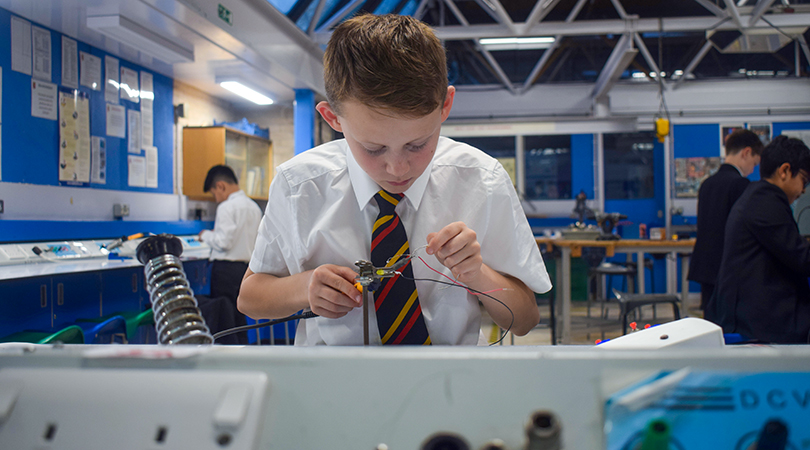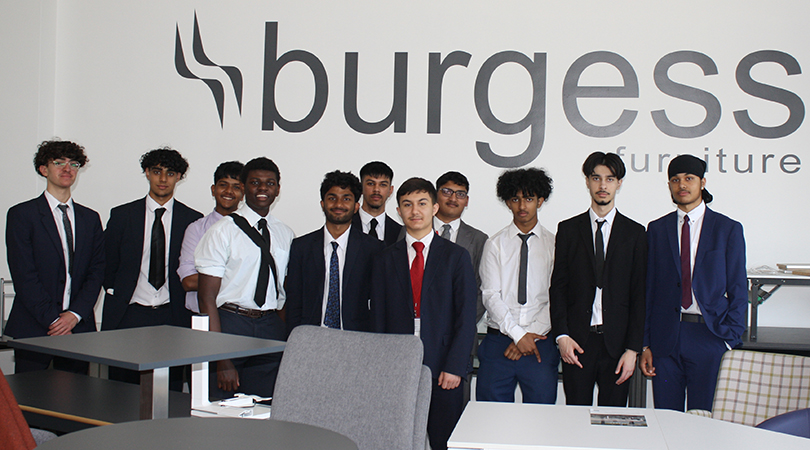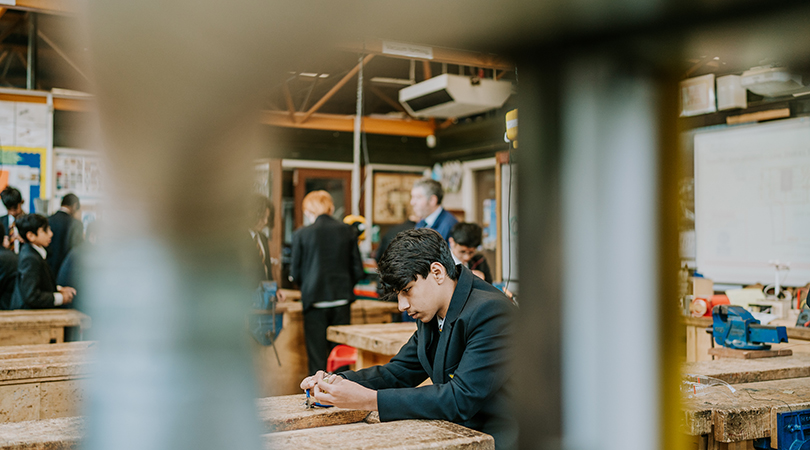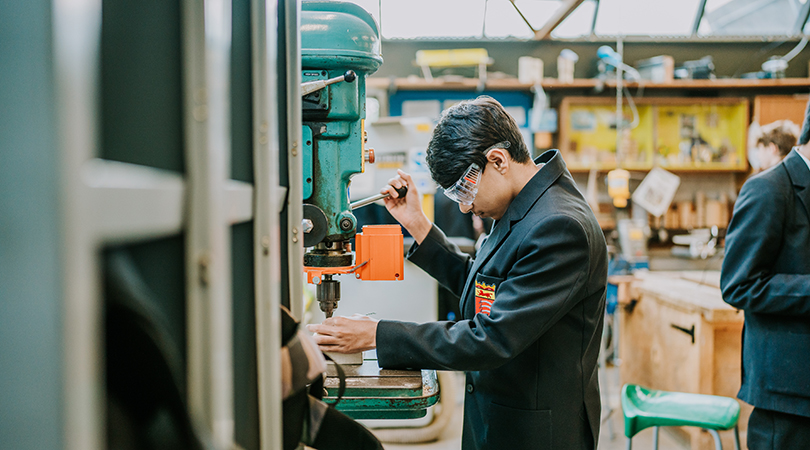Students of Design & Technology consider all the things people make and do to their natural environment in order to get the things they want and need. Students learn about the breadth of technology including computers and how to apply them, but it is more than just computers. They also learn about engineering and how to apply mathematics and science to solve real-world problems. Students develop enduring ideas of design and technology, such as knowledge of materials, functionality, manufacturing, design and critique, and they explore the relationship between design and technology and the society in which they live.
Summary
- Through D&T, people develop technologies and products to intervene in the natural and made worlds;
- D&T uses knowledge, skill and understanding from a wide range of sources, especially (but not exclusively) science and mathematics;
- There are always many possible and valid solutions to technological and product development challenges, some of which will meet these challenges better than others;
- The worth of technologies and products developed by people is a matter of judgement;
- Technologies and products always have unintended consequences beyond intended benefit which cannot be predicted by those who develop them.
Curriculum Content
Curriculum
Touch Sensors
Pupils develop their understanding of manufacturing electronic products through the development of a touch sensitive electronic fan. They are introduced to a variety of electronic components, and they learn how to solder. They develop an understanding of electrical and electronic concepts, and an awareness of possible inputs and outputs that can be linked using a Darlington Pair. They design and make a system to solve a real world problem.
Art Deco Clock
Pupils further develop their ability to work with wood and plastic. They develop their awareness of how to combine materials through focused tasks, based on combining and interlocking. They study the local built environment of West London, with particular focus on the Art Deco mile, to help inspire them to design and make a creative wall clock.
Assessment
Touch Sensors
Pupils are assessed for their knowledge and understanding of the electronics involved in their product, and for the quality of their finished practical work.
Art Deco Clock
Pupils are assessed for their ability to create a variety of well-drawn and annotated ideas, their ability to evaluate a range of proposals and existing designs, their technical knowledge of the materials and manufacturing processes involved in their product and for the quality of their making.
Progress & Preparation Activities (PPA)
PPA is set on Insight / Parent Portal by class teachers generally on a fortnightly basis.
Further Resources
The school has a subscription to The Day, an online news service for schools. Click the button to the right, then browse ‘Subjects’ in the top menu to find DT resources.
Please see below for a number of resources to maximise students’ progress during their Year 7 curriculum.
- Technology Student – pupils can further their understanding of the electronics, mechanisms and CAD/CAM topics studied in Year 7.
Curriculum
Musical Night Light
Pupils develop their understanding of the electronics of embedded intelligence. They are introduced to microcontroller integrated circuits via the Genie C08 microcontroller. They increase their familiarity with computer programming using flowcharts, and they use this knowledge to develop a program which they download onto a microcontroller circuit. They learn about pewter casting and copper enamelling, and they identify a suitable target market for their product. Finally, they design and make an attractive musical box into which they embed their circuit.
Pupils also develop their understanding and awareness of the properties of a wide range of resistant materials. They learn how to develop a range of imaginative and well-drawn design ideas. They study the working properties of various sheet materials, such as copper, polypropylene, HIPS and plywood. They develop their model making techniques using a variety of joining processes. They also learn how to use CAD/CAM and the laser cutter to ensure that their products are produced to a high-quality standard.
Assessment
Musical Night Light
Pupils are assessed for their ability to produce appropriate engineering drawings, their ability to evaluate a range of existing designs, their technical knowledge of the electronics, programming methods, materials and manufacturing processes involved in their product and for the quality of their making.
Pupils are also assessed for their ability to create a variety of well-drawn and annotated ideas, their ability to evaluate a range of proposals and existing designs, their technical knowledge of the materials and manufacturing processes involved in their product and for the quality of their making.
Progress & Preparation Activities (PPA)
PPA is set on Insight / Parent Portal by class teachers generally on a weekly basis.
Further Resources
The school has a subscription to The Day, an online news service for schools. Click the button to the right, then browse ‘Subjects’ in the top menu to find DT resources.
Please see below for a number of resources to maximise students’ progress during their Year 8 curriculum.
- Picaxe – an alternative microcontroller system for pupils wishing to make independent progress.
Curriculum
Mechanisms – Robotic Arm
In this project pupils develop their understanding of mechanisms through investigating the context of ‘automata’. They are taught about a range of mechanisms which they are expected to incorporate into a range of imaginative design solutions. They use product analysis and context analysis to identify a key requirements, and then apply their knowledge of mechanisms, paper and board and a variety of graphic and resistant materials to produce an imaginative design solution. They use both physical and mathematical modelling to develop their ideas.
Smart Lighting
Pupils further develop their understanding of the electronics of embedded intelligence and their understanding of materials and processes. They are re-introduced to the Genie 084 microcontroller. They further increase their familiarity with computer programming using flowcharts, and they use this knowledge to develop a program which they download onto a microcontroller circuit. They study a variety of disruptive technologies. They develop their circuit into a creative design solution for a stylish light to be mass/batch produced by studying existing products..
Assessment
Mechanisms – Robotic Arm
Pupils are assessed for their ability to produce appropriate engineering drawings, for their ability to create a variety of well-drawn and annotated ideas, their ability to evaluate a range of existing designs, their technical knowledge of the mechanisms, materials and manufacturing processes involved in the development of a mechanical toy.
Smart Lighting
Pupils are assessed for their ability to produce appropriate engineering drawings, their ability to evaluate a range of existing designs, their technical knowledge of the electronics, programming methods, mechanisms, materials and manufacturing processes involved in their product and for the quality of their making.
Progress & Preparation Activities (PPA)
PPA is set on Insight / Parent Portal by class teachers generally on a weekly basis.
Further Resources
The school has a subscription to The Day, an online news service for schools. Click the button to the right, then browse ‘Subjects’ in the top menu to find DT resources.
Please see below for a number of resources to maximise students’ progress during their Year 9 curriculum.
- IKEA – pupils can use this source when developing their research in Year 9.
- Technology Student – pupils can further their understanding of the electronics and material properties topics studied in Year 9.
Summary
Pupils undertake a major project in each discipline, and their subject knowledge is externally-tested at the end of the two-year course with a two-hour written examination. The coursework project constitutes 60% of the GCSE, and the examination 40%.
GCSE Engineering
Level: GCSE
Examination Board: AQA
Curriculum
Pupils investigate a variety of electronic devices and circuitry through a systems approach. They then use this knowledge to design and make a suitable electronic circuit to solve a given problem.
- Engineering materials
- Engineering manufacturing processes
- Systems
- Testing and investigation
- The impact of modern technologies
- Practical engineering skills
Assessment
Unit 1
Written paper – End of year mock examination to assess their progress with their theory knowledge (does not count towards their final GCSE).
Unit 2
Controlled assessment preparation – application of skills, knowledge and understanding in a practical context, including the production of engineering drawings, planning schedules, practical work, and evidence of testing, analysis and evaluation skills.
Further Resources
The school has a subscription to The Day, an online news service for schools. Click the button to the right, then browse ‘Subjects’ in the top menu to find DT resources.
Please see below for a number of resources to maximise students’ progress during their Year 10 curriculum.
- Technology Student – excellent revision resources for Year 10 students.
- AQA – examination board website, offering specifications, mark schemes and past papers.
- D&T Association – fantastic learning resources for students.
Curriculum
Pupils investigate a variety of electronic devices and circuitry through a systems approach. They then use this knowledge to design and make a suitable electronic circuit to solve a given problem.
- Engineering materials
- Engineering manufacturing processes
- Systems
- Testing and investigation
- The impact of modern technologies
- Practical engineering skills
Assessment
Unit 1
Written examination – 2 hours – 60% of GCSE
Unit 2
Controlled Assessment – Coursework portfolio and practical assessment – 40% of GCSE
Further Resources
The school has a subscription to The Day, an online news service for schools. Click the button to the right, then browse ‘Subjects’ in the top menu to find DT resources.
Please see below for a number of resources to maximise students’ progress during their Year 11 curriculum.
- Technology Student – excellent revision resources for Year 10 students.
- AQA – examination board website, offering specifications, mark schemes and past papers.
- D&T Association – fantastic learning resources for students.
Level 1/2 Vocational Award in Engineering
Level: GCSE
Examination Board: WJC/Eduqas
Curriculum
- Understanding engineering drawings
- Planning operations
- Using engineering tools and equipment
- Implementing engineering processes
- Understanding function and meeting requirements
- Proposing design solutions
- Communicating an engineered design solution
- Solving applied engineering problems
- Understanding the effects of engineering achievements
- Understanding properties of engineering materials
- Understanding methods of preparation, forming, joining and finishing of engineering materials
- Solving engineering problems
Assessment
Component 1
Written examination – End of year mock examination to assess their progress with their theory knowledge
Further Resources
The school has a subscription to The Day, an online news service for schools. Click the button to the right, then browse ‘Subjects’ in the top menu to find DT resources.
Please see below for a number of resources to maximise students’ progress during their Year 10 curriculum.
- Software for Education – excellent revision resources for Year 10 students.
Curriculum
Pupils investigate a variety of electronic devices and circuitry through a systems approach. They then use this knowledge to design and make a suitable electronic circuit to solve a given problem.
- Understanding engineering drawings
- Planning operations
- Using engineering tools and equipment
- Implementing engineering processes
- Understanding function and meeting requirements
- Proposing design solutions
- Communicating an engineered design solution
- Solving applied engineering problems
- Understanding the effects of engineering achievements
- Understanding properties of engineering materials
- Understanding methods of preparation, forming, joining and finishing of engineering materials
- Solving engineering problems
Assessment
Unit 1 – Manufacturing Engineering Products
Controlled assessment – 20 hours – 40% of grade
Unit 2 – Designing Engineering Products
Controlled assessment – 10 hours – 20% of grade
Unit 3 – Solving Engineering Problems
Written examination – 1 hour 30 minutes – 40% of grade
Further Resources
The school has a subscription to The Day, an online news service for schools. Click the button to the right, then browse ‘Subjects’ in the top menu to find DT resources.
Please see below for a number of resources to maximise students’ progress during their Year 11 curriculum.
- Technology Student – excellent revision resources for Year 10 students.
Summary
In Design Engineering, boys undertake a major project in each year, and their subject knowledge is externally-tested in a single examination at the end of both Year 12 and Year 13. The coursework component accounts for 50% of the final grade, with the written examinations accounting for the remaining 50%.
A level Design and Technology: Design Engineering
Level: A-Level
Examination Board: OCR
Curriculum
In Year 12, students will study the following topics:
- Introduction to Design Engineering
- Development of 2D & 3D drawing and CAD skills
- Selecting materials and components
- Mechatronics
- Health and safety
- Manipulating materials
- Production methods
- Material science and structural integrity
- Product analysis skills leading to the Iterative Design Project
- Further development of designing and making skills through up-cycling project
Assessment
Component 1 – Principles of Design Engineering
Written examination – 1 hour
Students:
- Analyse existing products
- Demonstrate applied mathematical skills
- Demonstrate their technical knowledge of materials, product functionality, manufacturing processes and techniques
- Undertake case studies to demonstrate their understanding of wider social, moral and environmental issues that impact on the design and manufacturing industries.
Component 2 – Problem solving in Design Engineering
Written examination – 1 hour
Students:
- Apply their knowledge, understanding and skills of designing and manufacturing prototypes and products to given situations and problems
- Demonstrate their higher thinking skills to solve problems and evaluate situations and suitability of design solutions.
Further Resources
The school has a subscription to The Day, an online news service for schools. Click the button to the right, then browse ‘Subjects’ in the top menu to find DT resources.
Please see below for a number of resources to maximise students’ progress during their Year 12 curriculum.
- Electronics Club – a website for anyone wishing to learn about electronics.
- OCR – past papers, specification, and other assessment materials.
Curriculum
In Year 13, students take component 3 – the iterative design project.
The ‘Iterative Design Project’ requires learners to undertake a substantial design, make and evaluate project centred on the iterative processes of explore, create and evaluate.
Learners identify a design opportunity or problem from a context of their own choice, and create a portfolio of evidence in real time through the project to demonstrate their competence.
Assessment
Component 1 – Principles of Design Engineering
Written examination – 1 hour 30 minutes – 26.7% of A level
Component 2 – Problem Solving in Design Engineering
Written examination – 1 hour 45 minutes – 23.3% of A level.
Component 3 – Iterative Design Project
Iterative design project – 50% of A level
Further Resources
The school has a subscription to The Day, an online news service for schools. Click the button to the right, then browse ‘Subjects’ in the top menu to find DT resources.
Please see below for a number of resources to maximise students’ progress during their Year 13 curriculum.
- Software for Education – electronics tutorial.
- STEM Engineering Club





